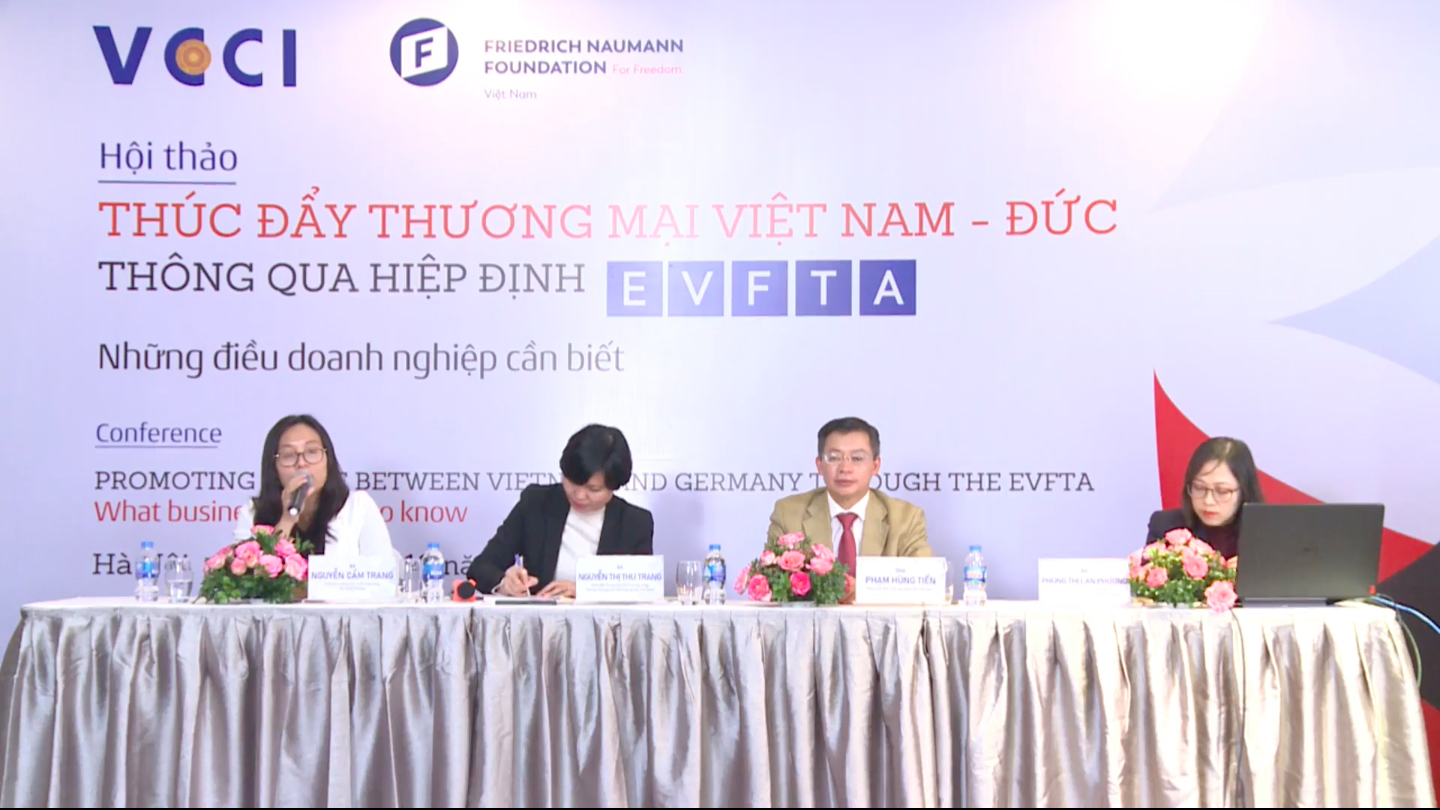German businesses see huge opportunities in Vietnam
The EU-Vietnam Free Trade Agreement is seen as the key factor that spearheads a promising period in Vietnam – Germany trade relations.
German businesses see huge opportunities in Vietnam, especially in renewables, vocational training, manufacturing, and pharmacy.
| Overview of the conference. Photo: Ngoc Thuy |
Pham Hung Tien, vice director of the Friedrich Naumann Foundation Institute (FNF) in Vietnam, shared the view at a conference discussing Vietnam-Germany trade relations held today [December 14].
According to Tien, German companies have shown interest in wind power projects in Binh Dinh, Binh Thuan, and Ninh Thuan provinces, noting this is a potential field for both sides to promote green growth development.
Though Vietnam and Germany have cooperated in vocational training for over 20 years, there remains plenty of room for greater improvements.
“The young and dynamic Vietnamese workforce with better skills could be a pulling factor to attract more investment from German companies in the manufacturing sector. In long term, this would help enhance local companies’ capabilities to become suppliers for their German peers operating in Vietnam,” Tien said.
Tien pointed out the fact that out of a modest 380 ongoing projects of German investors in Vietnam, only 60 are in the fields of manufacturing and processing.
“Vietnam as a fast-growing economy with a rapidly expanding middle class is among destinations that German businesses are looking to build car manufacturing/assembling factories,” Tien said.
The immediate goal would be to support the production of car parts and accessories for German car manufacturers already in Vietnam, such as Volkswagen, Mercedes, or BMW, he continued.
Another field for cooperation is the pharmacy, for which Tien said Vietnam alongside India could become an attractive option for German companies that want to diversify their supply chains.
“Foundations are there for Vietnam and Germany to cooperate and create products, services capable of competing at the regional level, especially in terms of cost and quality,” he stressed.
Echoing Tien’s view, Vice Chairman of Vietnam Chamber of Commerce and Industry (VCCI) Hoang Quang Phong noted for 10 years since the establishment of the Vietnam-Germany strategic partnership (2011-2021), Germany has remained one of the most important trade partners for Vietnam.
Bilateral trade turnover rose by 80% from US$5.6 billion in 2011 to $10 billion in 2020. Germany was Vietnam’s second-largest export market in the EU, behind the Netherlands, and the seventh globally.
“More importantly, both markets are complementary in nature rather than in direct competition,” Phong said.
Phong, however, noted there remained room for greater trade relations, as the bilateral trade turnover so far only made up 1.83% of Vietnam’s total trade, significantly lower than turnover from trading with China (24.41%), the US (16.65%) or South Korea (12.11%).
In this case, the EU-Vietnam Free Trade Agreement (EVFTA) is seen as the key factor that spearheads a promising period in Vietnam – Germany trade relations, Phong suggested.
Biggest challenge
Nguyen Cam Trang, deputy head of the Import-Export Department under the Ministry of Industry and Trade (MoIT), added as the Netherlands remains Vietnam’s largest export market in Europe due to its location as a transit hub, Germany’s second place is mainly due to “its sheer market size.”
According to Trang, Germany is currently the world’s third-largest importer with a value of $1.17 trillion per year, but the import value from Vietnam only accounts for 1%, or $11.7 billion, which leaves much space for improvement, especially with the EVFTA in place.
“As soon as the EVFTA comes into effect, it would eliminate 85.6% of tariff lines, equivalent to 70.3% of Vietnam’s export turnover to the EU,” Trang said.
“In a seven-year time, such rate would rise to 99.2% or 99.7% of Vietnam’s exports to the bloc,” she continued.
She considered a promising sign to the fact that exports to Germany, one year after the deal [August 2020 to July 2021], reached $7.1 billion, a 9% increase year-on-year. In return, imports also rose by 8.4% to $3.6 billion.
Among key export products that have benefited from the EVFTA, machinery and equipment took the top spot by a surge of 83.6% to $1.02 billion, followed by computers and electronic products at $627 million, up 34%, and seafood ($200 million), up 15.5%.
“These positive figures show the effectiveness of the deal,” Trang said.
In long term, Trang called for businesses to pay more attention to rules of origin to benefit from the EVFTA, a key requirement for Vietnamese products to continue penetrating the EU and German markets.
“Local enterprises should plan investment in machinery, equipment, and technology to improve domestic production capacity,” she continued.
Meanwhile, the Director of the WTO Center and Integration under the VCCI Nguyen Thi Thu Trang warned local firms to soon take advantage of the EVFTA before other countries in the region would reach a similar trade deal with the EU.
“The EU is negotiating trade deals with China, Indonesia, and the Philippines, among others. It is, therefore, essential for companies to utilize the EVFTA as much as possible before the competition becomes harder,” she added.
Upon breaking down Germany’s main imports from Vietnam, local firms could still improve in areas that have relatively low turnover in the European country’ total imports, including furniture with 1.31%, optical and medical instruments (0.58%), machinery and mechanical appliances (0.81%), and electrical machinery and equipment (2.35%).
“The biggest challenge for Vietnam in its trade relations with Germany and other European countries is being unable to grasp opportunities and realize the potential brought by the EVFTA,” Trang concluded.
Total FDI commitments in Hanoi in 2021 are estimated at $1.5 billion, including 364 fresh projects of $238 million and 146 existing ones being pumped $813 million. Investors also contributed capital to 465 projects with $448 million. |











